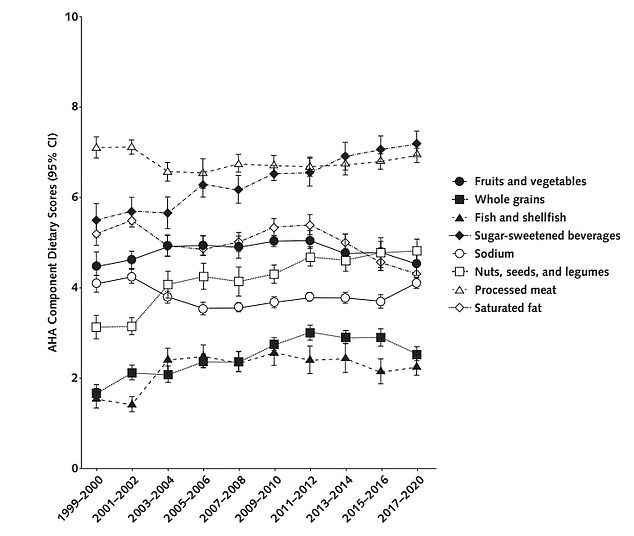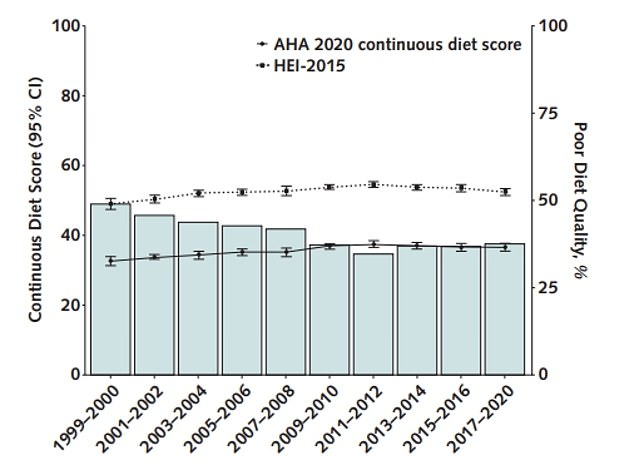American diets have gotten HEALTHIER over the past 20 years…we’re eating LESS sugar, intriguing new data shows
Intriguing new data suggests that many more Americans are eating healthy than they were two decades ago – casting doubt on previous studies that suggest our daily menus are worse than ever before.
Researchers from Tufts University in Massachusetts analyzed the diets of 51,700 Americans aged 20 and older who responded to the National Health and Nutrition Examination Survey (NHANES) between 1999 and 2020.
They assigned “diet scores” to people based on how closely they followed the American Heart Association diet, which recommends a wide variety of fruits and vegetables, whole grains, plant proteins, fish and minimal sugar and alcohol.
A poor diet was defined as less than 40 percent compliance with the AHA guidelines. Over the study period, the proportion of adults with a poor diet fell from 49 percent to 37 percent.
However, the researchers stated that the percentage of people with poor diets is still too high, contributing to America’s obesity epidemic.
High-fat diets are known to increase the risk of obesity, heart disease and type 2 diabetes
While the increase in body mass index appears to be slowing, more Americans than ever are classified as severely obese. Stat news reported.
Senior author of the study Dr. Dariush Mozaffarian, a cardiologist and director of the Food is Medicine Institute, said, “While we have seen some modest improvements in the American diet over the past two decades, those improvements are not reaching everyone, and many Americans are. worse food.’
Researchers involved in the new study also scored average and ideal diets.
An intermediate diet had AHA adherence of 40 to 79.9 percent and an ideal diet had at least 80 percent adherence.
Additional results showed that the share of Americans with average adherence increased from 51 percent to 61 percent and the share of Americans with an ideal diet increased but remained very low, from 0.66 percent to 1.6 percent.
However, the changes were not uniform across all demographic groups. Those with poor nutrition dropped from 48 percent to 33 percent, only among adults with food security: access to and ability to afford healthy food.
However, there was no significant decrease – 51 percent to 48 percent – for people with food insecurity.
Dr. Mozaffarian viewed the demographic disparity as a “national nutritional crisis.”
He said, “These diseases affect all Americans, but especially those who are socioeconomically and geographically vulnerable. We must address nutritional security and other social determinants of health, including housing, transportation, fair wages and structural racism, to address the human and economic costs of poor nutrition.”

The chart above shows estimated trends in adherence to various components of the AHA Dietary Guidelines

The chart above shows estimated trends in adherence to the AHA Dietary Guidelines and the proportion of US adults with poor nutrition scores
A poor diet has been linked to numerous health problems, including heart disease, obesity, diabetes and some cancers.
The researchers said that given the low number of Americans following ideal diets, it is not surprising that national rates of diabetes and obesity continue to rise, “indicating the need for substantial further improvements in diet quality before the prevalence of These very nutritionally sensitive conditions may increase. are starting to decline.”
According to the FDA, 1 million Americans die every year from diet-related diseases.
Dr. Mozaffarian added, “Our new research shows that the nation cannot achieve nutrition and health equity until we address the barriers many Americans face when it comes to accessing and eating nutritious food.”
Researchers said specific dietary changes contributed to the trends, including higher intake of nuts, seeds, whole grains, poultry, cheese and eggs.
There was lower consumption of refined grains – such as white bread – drinks with added sugar, fruit juice and milk.
The intake of fruit, vegetables, meat products and salt remained fairly stable.
Although overall trends were evident, improvements in diet quality were highest among younger adults, women, Hispanic adults, and those with higher levels of education, income, food security, and private health insurance.
Diet improvement was lower among older adults, men, black adults, and those with lower levels of education, income, food security, and private health insurance.
Study author Junxiu Liu, assistant professor at the Icahn School of Medicine at Mount Sinai, said: ‘While some improvement, especially lower consumption of added sugars and fruit drinks, is encouraging to see, we still have a long way to go. especially for people from marginalized communities and backgrounds.’
The study was published Monday in the Annals of Internal Medicine.
